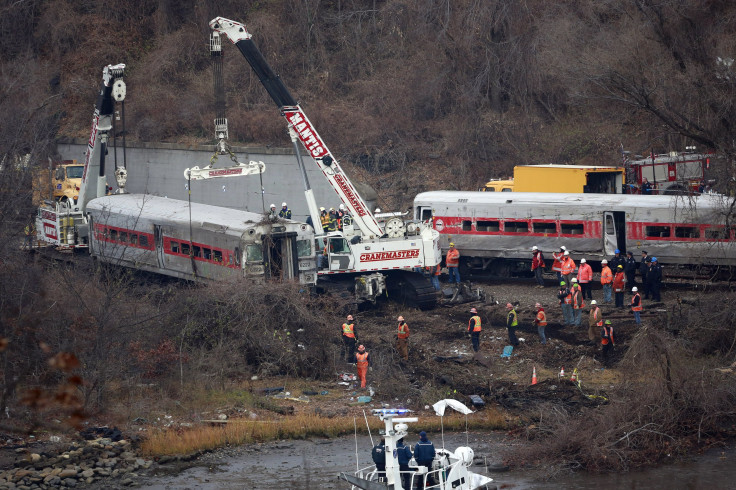What Caused Deadly Bronx Train Derailment? Investigation Reveals Metro-North Traveling 82 MPH When It Jumped Tracks

Investigators are trying to make sense of what caused Sunday’s deadly Metro-North train derailment in the Bronx, and are finding clues as to why the commuter train jumped the tracks. Authorities located both event recorders, one in the rear locomotive and one in the train’s front car, and sent them to Washington, DC for analysis.
According to the National Transportation Safety Board, or NTSB, who is leading the investigation, initial analysis of the data logged on one of the recorders showed that the train was speeding at the time it crashed. “Preliminary info from event recorders shows train was traveling at approx. 82 mph as it entered the 30 mph curve,” the NTSB tweeted Monday.
The NTSB investigation also revealed that the Metro-North’s throttle was engaged until six seconds before the train skidded to a halt on its side. The breaks were applied just five seconds before the train came to a grinding stop, the NTSB noted on its Twitter account.
Authorities are trying to figure out if the deadly wreck was caused by human error or troubles with the breaks. When asked why the train was traveling at such an excessive speed, Earl Weener, a NTSB member, told The Associated Press, "That's the question we need to answer."
The NTSB’s tweets also revealed that investigators are tapping the cell phone of the engineer who was operating the train at the time it derailed. The engineer, identified by the New York Post as 46-year-old William Rockefeller, was injured during the Bronx train crash. Rockefeller, who was a Metro-North employee for 20 years and an engineer for 11, told authorities he tried to hit the brakes as the train came into the bend, but that they didn’t work.
The NTSB did note that the train had just successfully made nine station stops prior to the train’s derailment. “We are not aware of any prior issues with the brakes,” the NTSB tweeted.
"When I heard about the speed, I gulped. It kind of takes your breath away," Sen. Charles Schumer, D-N.Y., told NBC News. "There’s one obvious point here, which is that the train did make nine stops before coming to this curve. So clearly the brakes were working a short time before it came to this curve."
Authorities are waiting for the results of the engineer’s drug and alcohol tests. Those who know Rockefeller said he’s a good engineer. "He's a sincere human being with an impeccable record that I know of. He's diligent and competent," Anthony Bottalico, executive director of the rail employees union, told The Associated Press.
On Sunday morning, as the New York City-bound Metro-North commuter train made its way along the Hudson River, having departed Poughkeepsie around 5:55 a.m., it approached a sharp bend in the track near where the Hudson and Harlem rivers meet. The train was approaching the Spuyten Duyvil station in the Bronx when seven of its cars leaped off the tracks.
Four people were killed in the train crash. The victims were later identified as 58-year-old Jim Lovell of Cold Spring, N.Y.; 59-year-old James Ferrari of Montrose, N.Y.; 54-year-old Donna Smith of Newburgh, N.Y.; and 35-year-old Ahn Kisook of Queens, N.Y. Dozens more were injured, and 19 remained in the hospital as of Monday. One passenger is still in critical condition with a spinal cord injury, NBC News reported.
"It was a scene straight out of a sci-fi movie," Beth Barret, who was traveling on the Metro-North train when it derailed, told CNN. "Very surreal and very scary."
On Monday, workers began to lift the rail cars from their sides and place them back onto the tracks. Investigators continued to search through the wreckage for any clues as to what caused the crash, and cadaver dogs made one more sweep of the site.
© Copyright IBTimes 2024. All rights reserved.





















